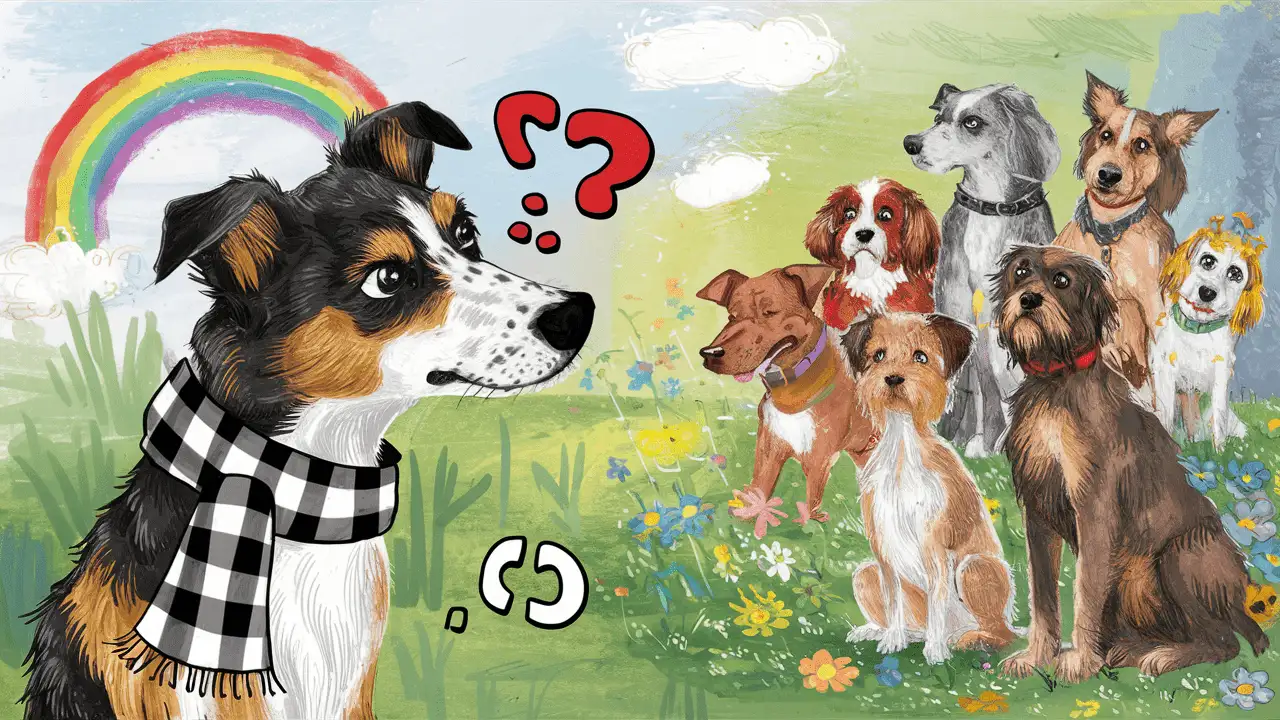Ever wondered what goes on inside your furry friend’s head? Can they appreciate the vibrant sunset you’re both gazing at, or is their view a muted, monochrome masterpiece? The truth is, Fido’s visual experience is definitely different from ours, but it’s not quite the black and white world we might imagine. Buckle up, pup lovers, because we’re diving into the fascinating world of canine color vision!
Seeing the World Through Doggy Goggles
Unlike humans with our fancy-schmancy trichromatic vision (yep, that means three cones for red, green, and blue), dogs are rocking a dichromatic system. This translates to just two cones, meaning their world is dominated by shades of blue and yellow. Woof woof! So, that fire hydrant you think is a brilliant red might appear more like a dull rust or brownish-gray to your pup. But wait, there’s more to the story!
Beyond Blue and Yellow: A World of Grays
While dogs might not be able to appreciate the full rainbow spectrum, they’re not exactly stuck in a sepia-toned movie either. Here’s the thing: their two cones are super sensitive to variations in blue and yellow, allowing them to see a wider range of those colors than humans can. This creates a world rich in blues, grays, and yellows, with subtle distinctions that might leave us human viewers scratching our heads. Imagine a world where every shade of gray has a distinct meaning, like a secret code only your dog can crack!
Seeing in the Dark: Night Vision Wins!
Now, let’s talk about something where dogs totally outshine us humans – night vision! Their retinas are packed with special cells called rods, which are like super-powered light detectors. This night vision advantage makes them total rockstars at catching frisbees in the twilight and navigating dimly lit rooms. So, next time you’re fumbling around in the dark, remember – your doggo is probably seeing everything perfectly clear!
So, Can Dogs See Red?
This is where things get interesting. The colors we perceive as red and green fall outside the range that dogs can detect very well. Reds might appear more like a dark gray or brown, while greens might look like a muted yellow or even just another shade of gray. But that doesn’t mean they can’t see these colors at all! In fact, studies have shown that dogs can differentiate between some shades of red and green, especially when there’s a high level of brightness.
More Than Just Color: The Power of Scent
While color vision might not be their strong suit, dogs have another incredible sense that more than makes up for it – their amazing sense of smell! A dog’s nose holds millions of olfactory receptors, allowing them to perceive scents at levels we can’t even imagine. For them, the world is a symphony of smells, a complex language that tells them everything from who’s been around to what kind of food is lurking in the next room. It’s like having a built-in GPS guided by delicious odors!
Living in a World of Sniffs and Shades
So, the next time you take your furry friend for a walk, remember – they’re experiencing the world in a unique way. Sure, they might not be picking out your favorite red outfit from across the park, but they’re definitely picking up on scents and subtle variations in light that we miss entirely. Their world is a fascinating blend of blues, yellows, grays, and a whole lot of amazing smells, making them the ultimate sniff-and-see explorers!
Beyond the Basics: Fun Facts About Doggy Vision
- Depth Perception: Dogs have decent depth perception, but it’s not quite as sharp as ours. This means they might misjudge distances sometimes, so be mindful of that when playing fetch!
- Motion Matters: Canine eyes are excellent at tracking movement. That’s why a squirrel darting across the yard is practically irresistible to your pup!
- Seeing Stars? Not Quite: Due to their limited color vision and focus on near objects, stargazing probably isn’t your dog’s favorite activity. But hey, they can still appreciate a good moonlit walk!
Living with a Color-Blind Canine
Even though their world might be a little less colorful than ours, there’s no need to feel sorry for your dog. They navigate their environment perfectly well using their other amazing senses. Here are some tips for training and interacting with your color-blind companion:
- Focus on Positive Reinforcement: Since they might not see hand signals as clearly, reward-based training is the way to go.
- Location, Location, Location: Use consistent locations for food, water, and toys.
- Light it Up!: Because dogs are more sensitive to variations in brightness and blue hues, using brightly colored toys (think blues and yellows) against contrasting backgrounds can help them see better during playtime.
- Sniffing Out Success: Remember their super sniffer? Utilize scent-based training to teach tricks and commands. Hide treats around the house and let your pup sniff them out – it’ll be a fun mental workout for them!
Beyond the Science: The Emotional Connection
While understanding how dogs see the world is paw-some, the most important thing is the connection we share with them. Whether they see a world in vibrant hues or subtle shades, the love and loyalty in their eyes shine through in any spectrum. So next time you lock eyes with your furry friend, remember – the bond you share transcends the limitations of sight. It’s a connection built on love, trust, and maybe a shared love for belly rubs (who can resist those?).
So, there you have it!
The mystery of canine color vision is unveiled. While they might not be seeing the world exactly as we do, their unique sensory experience allows them to navigate and interact with their environment in incredible ways. From their super night vision to their amazing sense of smell, dogs are truly remarkable creatures with a whole lot to offer. So, the next time you take your pup for a walk, appreciate the world through their eyes (or rather, nose) and celebrate the unique way they experience life’s colorful – or perhaps not so colorful – adventures!



